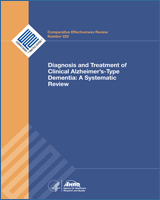NCBI Bookshelf. A service of the National Library of Medicine, National Institutes of Health.
Fink HA, Hemmy LS, Linskens EJ, et al. Diagnosis and Treatment of Clinical Alzheimer’s-Type Dementia: A Systematic Review [Internet]. Rockville (MD): Agency for Healthcare Research and Quality (US); 2020 Apr. (Comparative Effectiveness Review, No. 223.)

Diagnosis and Treatment of Clinical Alzheimer’s-Type Dementia: A Systematic Review [Internet].
Show detailsKey Messages
- For sertraline versus mirtazapine in individuals with mild to moderate CATD and depression:
- Insufficient evidence for depression, general behavior, quality of life, or serious adverse events.
- No evidence for agitation, aggression, psychosis, disinhibited sexual behavior, anxiety, or withdrawals due to adverse events.
- For memantine compared with continued antipsychotics in individuals with moderate to severe CATD receiving antipsychotics:
- Insufficient evidence for agitation, general behavior, or serious adverse events.
- No evidence for aggression, psychosis, disinhibited sexual behavior, anxiety, quality of life, or withdrawals due to adverse events.
Eligible Studies
We identified 12 eligible publications reporting 12 unique trials that directly compared effectiveness of different prescription drugs for treatment of BPSD in patients with CATD.331, 346, 347, 352, 353, 355, 360, 368, 379–382 Ten trials were assessed as high risk of bias (ROB) and excluded from analysis. Two remaining trials were rated medium ROB and included in our analysis.331, 368
Sertraline Versus Mirtazapine
Baseline Study Characteristics
One trial enrolled 215 participants with probable or possible CATD defined by the clinical criteria of the National Institute of Neurological and Communicative Disorders and Stroke and Alzheimer’s Disease and Related Disorders (NINCDS-ADRDA), and depression defined by Cornell Scale for Depression in Dementia (CSDD) score ≥8.368 All participants were receiving old-age psychiatry services from UK National Health Service centers and 14 percent lived in care homes. Mean participant age was 79 years, and 70 percent were female. Mean Mini-Mental State Exam (MMSE) score was 18.0, suggesting mild to moderate CATD severity. Mean Neuropsychiatric Inventory (NPI) and CSDD scores were 28.4 and 12.6, respectively. Participants were randomized to sertraline up to 150 mg/day or mirtazapine 45 mg/day for 39 weeks for treatment of depression. Appendix J provides detailed evidence tables, summary ROB assessments, and strength of evidence for key comparisons and outcomes.
Outcomes
Table 11.1 summarizes primary comparative effectiveness and harms outcomes. For comparative effectiveness, evidence was insufficient to draw conclusions about differences between sertraline and mirtazapine for depression, general behavior, or quality of life, and no data were reported for agitation, aggression, psychosis or disinhibited sexual behavior at 2 weeks or longer, or for anxiety at 24 weeks or longer. For caregiver outcomes, sertraline and mirtazapine did not statistically differ at 39 weeks for caregiver burden383 (standardized mean difference [SMD], 0.21 [95% confidence intervals (CI), ‑0.11 to 0.54]), caregiver general health questionnaire (GHQ-12) (SMD, 0.22 [95% CI, ‑0.11 to 0.55]), caregiver general quality of life mental component score (SF-12 MCS) (SMD, 0.04 [95% CI, ‑0.29 to 0.37]), or caregiver general quality of life physical component score (SF-12 PCS) (SMD, ‑0.12 [95% CI, ‑0.45 to 0.21]).368
For harms, evidence was insufficient to draw conclusions about differences between sertraline and mirtazapine for serious adverse events. Five deaths were reported for each treatment group, but no studies reported data on withdrawals due to adverse events, somnolence, confusion, falls, extrapyramidal symptoms or stroke.
Table 11.1
Summary of findings for primary outcomes: sertraline versus mirtazapine.
Variation in Outcomes by Participant or Drug Characteristics
Efficacy findings were reported to not differ in subgroup analyses stratified by baseline depression severity (CSDD score 8 to 11 vs. ≥12).368 No studies reported whether differences in treatment efficacy and harms between sertraline and mirtazapine varied as a function of participant characteristics or drug dose, duration, or delivery route.
Memantine Versus Antipsychotics
Baseline Study Characteristics
One trial enrolled 199 participants with probable or possible CATD defined by NINCDS-ADRDA clinical criteria who were living in care homes in the UK or Norway and already were receiving an antipsychotic. 331 Mean participant age was 83 years, and 69 percent were female. Mean MMSE score was 8, suggesting moderate to severe CATD. Mean NPI and Cohen-Mansfield Agitation Inventory (CMAI) scores were 17.6 and 51.4, respectively. Participants were randomized to antipsychotic continuation (risperidone 0.5 mg, olanzapine 5 mg, quetiapine 50 mg, or haloperidol 0.5 mg, once or twice daily as needed) or memantine (10-20 mg/day) for 24 weeks.
Outcomes
Table 11.2 summarizes primary comparative effectiveness and harms outcomes. For comparative effectiveness, evidence was insufficient to draw conclusions about differences between memantine and antipsychotics for agitation or general behavior, and no data were reported for aggression, psychosis or disinhibited sexual behavior at 2 weeks or longer, or for depression or anxiety at 24 weeks or longer.
For harms, evidence was insufficient to draw conclusions about differences between memantine and antipsychotics for serious adverse events. In the memantine group, there were no strokes and 9 percent of participants died, compared to the antipsychotic group with 2.5 percent incidence of stroke and 4 percent mortality. No studies reported data on withdrawals due to adverse events, somnolence, confusion, falls or extrapyramidal symptoms.
Table 11.2
Summary of findings for primary outcomes:* memantine versus antipsychotics.
Variation in Outcomes by Participant or Drug Characteristics
No studies reported data on whether comparative effectiveness and harms between memantine and antipsychotics varied as a function of patient characteristics, or drug dose, duration, or delivery route.
- Key Question 8: Prescription Drug Treatment Versus Other Active Treatment for Be...Key Question 8: Prescription Drug Treatment Versus Other Active Treatment for Behavioral and Psychological Symptoms of Dementia - Diagnosis and Treatment of Clinical Alzheimer’s-Type Dementia: A Systematic Review
Your browsing activity is empty.
Activity recording is turned off.
See more...